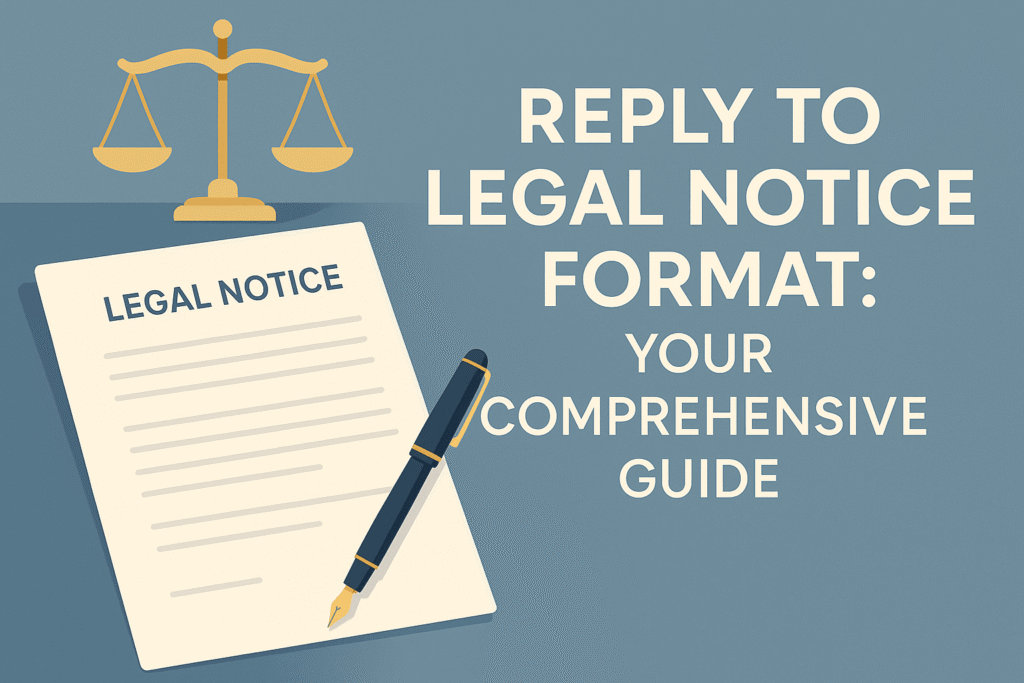Receiving a legal notice can be a daunting experience. It often signals a potential dispute or claim against you, and your immediate reaction might be one of concern. However, understanding the proper reply to legal notice format is not just about formality; it’s about safeguarding your rights, presenting your side of the story, and often, preventing further legal escalation. It is always best to respond to a legal notice in time to avoid future litigation.
At StrictlyLegal.in, we understand the complexities of legal communication. This guide will walk you through the essential elements and best practices for drafting an effective reply to a legal notice, ensuring your response is both legally sound and strategically advantageous.
Quick Reference: Standard Reply to Legal Notice Format
If you’re looking for a quick answer, here’s the standard structure every reply to a legal notice should follow. A proper reply begins with your contact details and the date, followed by the recipient’s information. The subject line should reference the original notice with its date and matter. Your reply must acknowledge receipt of the notice, address each allegation point-by-point with factual responses, cite supporting documents, propose a resolution or deny liability, reserve your legal rights, and conclude with a professional signature. Below, we break down each component in detail with practical examples you can adapt to your situation.
Table of Contents
Why is a Timely and Proper Reply Crucial?
Ignoring a legal notice is rarely a wise decision. Here’s why a prompt and well-structured reply is paramount:
- Avoid Adverse Inferences: Failing to respond within the stipulated timeframe (usually 15 to 30 days) can be interpreted by courts as an admission of the claims made against you, or at least a lack of intent to dispute them.
- Protect Your Rights: Your reply is your first formal opportunity to present your version of events, deny false allegations, and assert your legal position.
- Initiate Dialogue for Resolution: A well-drafted reply can open doors for negotiation, mediation, or arbitration, potentially resolving the dispute amicably without lengthy and expensive litigation.
- Build a Strong Legal Defense: It creates a record of your response, which can be crucial evidence if the matter proceeds to court.
Before You Draft: Essential Preparatory Steps
Before you even begin to think about the reply to legal notice format, take these vital steps:
- Read and Understand Thoroughly: Go through the legal notice multiple times. Identify the sender, the specific claims or allegations made, the legal provisions invoked, and the relief sought. Note down the date of receipt and the deadline for response.
- Gather All Relevant Documents: Collect any contracts, agreements, invoices, communication (emails, letters, messages), payment records, or other evidence that pertains to the matter. These documents will support your factual assertions in the reply.
- Consult a Legal Professional: While it’s technically possible to draft a reply yourself, it is highly recommended to consult with a lawyer. A legal expert can:
- Analyze the notice for its legal implications.
- Advise you on the best course of action.
- Ensure your reply is legally compliant and doesn’t inadvertently admit liability.
- Help you articulate your position clearly and concisely.
The Essential Reply to Legal Notice Format: A Step-by-Step Breakdown
A formal reply to a legal notice typically follows a structured format to ensure clarity, professionalism, and legal efficacy.
1. The Header
This section sets the formal tone and identifies the parties involved.
- Sender’s Details (Your Lawyer’s Letterhead or Your Details):
- Your Name/Law Firm Name
- Address
- Contact Number
- Date: The date of drafting the reply.
- Recipient’s Details:
- Name and Address of the Sender of the Original Legal Notice (or their Advocate)
- Subject Line: A clear and concise subject line, referencing the original legal notice.
- Example: “Subject: Reply to your Legal Notice dated [Date of Original Notice] concerning [Brief description of the matter]”
2. Acknowledgement of Receipt
Begin by formally acknowledging the receipt of the original legal notice.
- Example: “Ref: Your Legal Notice dated [Date of Original Notice] received by me/my client on [Date of Receipt].”
- “Under instructions from and on behalf of my client, [Your Name/Company Name], residing/having its office at [Your Address], I hereby submit the following reply to your legal notice dated [Date of Original Notice].”
3. Preliminary Submissions/Objections (Optional but often important)
This section is used to raise any initial legal or factual objections to the notice itself, before addressing the merits of the claims. This might include:
- Challenging the jurisdiction of the sender.
- Stating that the notice is baseless, frivolous, or vexatious.
- Denying any malafide intentions or false allegations.
- Asserting that the notice is sent with malicious intent to harass or extort.
4. Point-by-Point Reply on Merits
This is the most critical part. You must respond to each and every allegation or claim made in the original legal notice, paragraph by paragraph.
- Deny, Admit, or Explain: For each point in the original notice:
- Deny: If the claim is false, explicitly deny it.
- Admit: If a fact is true, you can admit it, but be cautious about admitting liability.
- Explain: Provide your factual counter-statement or explanation for the allegations.
- Use Clear and Precise Language: Avoid ambiguity. Stick to facts.
- Refer to Supporting Documents: Where applicable, mention and attach relevant documents that support your denial or explanation.
- Example: “With reference to Paragraph 3 of your notice, it is categorically denied that [allegation]. On the contrary, vide Invoice No. [Invoice Number] dated [Date], [explain your factual position]. A copy of the said invoice is annexed herewith as Annexure ‘A’.”
- Maintain a Professional Tone: Even if the allegations are inflammatory, your reply must remain objective and professional.
5. Legal Grounds and Justifications
If applicable, cite relevant legal provisions, clauses from contracts, or precedents that support your arguments. This demonstrates your understanding of the law and strengthens your position.
6. Relief Sought / Proposed Solution
Clearly state what you demand or propose as a resolution. This could include:
- Denial of liability and a demand for the withdrawal of the notice.
- A counter-claim.
- A proposal for settlement, negotiation, or alternative dispute resolution (e.g., mediation).
- A request for further clarification.
7. Reservation of Rights
Always include a clause reserving your right to initiate legal proceedings against the sender for defamation, malicious prosecution, or any other relevant cause of action if they persist with false claims or vexatious litigation.
- Example: “My client reserves all rights to initiate appropriate legal proceedings, civil and/or criminal, against your client for the false and baseless allegations made in your notice, and for any damages incurred due to such actions.”
8. Closing and Signature
- Formal Closing: “Yours faithfully,” or “Sincerely,”
- Signature: Your signature (or your lawyer’s signature).
- Your Name/Lawyer’s Name:
- Designation: (e.g., Advocate for [Your Client’s Name])
Important Tips for Drafting an Effective Reply
- Maintain a Professional Tone: Even if you feel aggrieved, avoid emotional, abusive, or defamatory language. Focus on facts and legal arguments.
- Be Factual and Precise: Every statement should be verifiable and accurate. Avoid vague statements.
- Avoid Unnecessary Information: Stick to the points raised in the original notice and your counter-arguments. Do not introduce irrelevant details.
- Attach Supporting Documents: Always attach clear copies of all documents you refer to in your reply.
- Keep Copies: Retain a copy of the original legal notice, your drafted reply, and proof of dispatch (e.g., postal receipt, courier slip, acknowledgment).
- Send Through a Reliable Mode: Dispatch the reply via Registered AD (Acknowledgement Due) post or a reputed courier service to ensure proof of delivery.
What Happens if You Don’t Reply?
As mentioned, failing to reply can lead to severe consequences, including:
- The sender may assume you admit their claims.
- They might proceed with filing a lawsuit, and your silence could be used against you in court.
- You lose the opportunity to settle the matter amicably outside of court.
When to Seek Legal Assistance
While this guide provides a clear reply to legal notice format, every legal notice is unique. The nuances of the law and the specific facts of your case require expert interpretation. Therefore, it is always advisable to engage a qualified lawyer to:
- Draft the reply on your behalf.
- Review a draft you have prepared.
- Advise you on the best legal strategy.
- Represent you in subsequent proceedings.
If you are not a lawyer you can always seek legal assistance from online platforms like vakiltech.in who would help you find a local lawyer who would respond to your legal notice in a professional manner and yet only charge you a very reasonable fee. Be it a Matrimonial Disputes, Commercial Disputes or a mere family dispute. If you are not a lawyer it is always advisable to take help from a professional as one wrong acknowledgement can bring you trouble.
Reply to Legal Notice Format for Different Situations
The format of your reply may need to be tailored based on the specific type of legal notice you’ve received. For cheque bounce cases under Section 138 of the Negotiable Instruments Act, your reply should specifically address payment details, reasons for dishonor, and any evidence of settlement attempts. In property dispute notices, include references to sale deeds, possession documents, and payment receipts. For defamation notices, your reply should carefully address each allegedly defamatory statement without admitting fault while providing context or truth as a defense. Consumer complaint replies require detailed explanations of service delivery, warranty terms, and quality assurance measures. Employment-related notice replies should reference employment contracts, company policies, and documented performance records. Regardless of the situation, maintain the core structure outlined above while incorporating specific evidence and legal provisions relevant to your case.
Common Mistakes to Avoid When Replying to a Legal Notice:
- Using emotional or abusive language instead of maintaining professionalism
- Admitting liability unintentionally through vague statements
- Missing the reply deadline or not requesting an extension
- Failing to attach documentary evidence referenced in the reply
- Not keeping copies of the reply and proof of delivery
- Addressing only some allegations while ignoring others
- Making counter-allegations without proper evidence
Conclusion
Responding to a legal notice promptly and effectively is a critical step in managing legal disputes. By understanding and adhering to the proper reply to legal notice format, you can articulate your position clearly, protect your interests, and pave the way for a favorable resolution. Don’t let a legal notice intimidate you; empower yourself with a well-informed and professionally drafted reply.
The standard format includes eight key components: (1) Header with your details and date, (2) Recipient’s information, (3) Subject line referencing the original notice, (4) Acknowledgment of receipt, (5) Point-by-point response to allegations, (6) Legal grounds and supporting evidence, (7) Proposed resolution or denial of liability, and (8) Formal closing with signature and reservation of rights clause.
You typically have 15 to 30 days to reply to a legal notice, as specified in the notice itself. It’s crucial to respond within this timeframe, as failure to do so may be interpreted by courts as an admission of the claims. If you need more time, formally request an extension in writing before the deadline expires.
While templates provide a useful starting point for understanding the structure, you should never use them verbatim. Each legal notice is unique, and your reply must specifically address the allegations made against you with relevant facts and evidence. A generic template response may inadvertently admit liability or omit crucial defenses specific to your case.
While it’s not legally mandatory to hire a lawyer, it is highly recommended, especially for complex matters. A lawyer can identify legal implications you might miss, ensure your reply doesn’t inadvertently admit liability, cite relevant laws and precedents, and strengthen your position. For serious matters involving significant financial claims or criminal allegations, professional legal assistance is essential.
You should only admit facts that are undeniably true and don’t establish liability. Be extremely cautious about admissions, as they can be used against you in court. For example, you might admit receiving a product but deny that it was defective. It’s safer to explain your position without making broad admissions. Consult a lawyer if you’re unsure what to admit.
After you send your reply, several outcomes are possible: the sender may accept your position and drop the matter, they may reject your reply and file a lawsuit, they may propose negotiation or mediation, or they may simply not respond. Maintain proof of sending your reply (registered post receipt, courier tracking) as this evidence will be crucial if the matter proceeds to court.
While email is faster, it’s advisable to send your reply via Registered Post with Acknowledgment Due (RPAD) or through a reputable courier service. This provides concrete proof of delivery. You can also send a copy via email for speed, but the physical mailed copy with proof of delivery is what holds legal weight.
Your subject line should be clear and specific. Use this format: “Reply to Legal Notice dated [Date] regarding [Brief matter description]” or “Response to Your Legal Notice Ref: [Reference Number] dated [Date] – [Matter]”. This immediately identifies your reply and links it to the original notice.
Yes, absolutely. Any document you reference in your reply should be attached as an annexure. This includes contracts, invoices, emails, payment receipts, correspondence, or any other evidence supporting your position. Label them clearly as Annexure A, B, C, etc., and reference them in the body of your reply.
A reservation of rights clause states that you reserve the right to take legal action against the sender if they proceed with false or vexatious claims. It typically reads: “My client reserves all rights to initiate appropriate legal proceedings against your client for the false allegations made and for any damages incurred.” This protects your ability to file counter-claims or defamation suits.
No, you should never ignore a legal notice, even if you believe it’s completely baseless. Ignoring it can result in the court assuming you have no defense, which may lead to a default judgment against you. Always respond within the stipulated time, clearly stating why the notice is baseless and providing evidence to support your position.
Address each allegation separately using numbered paragraphs or sub-headings. For example: “Response to Allegation 1 (Contract Breach):”, “Response to Allegation 2 (Payment Default):”, etc. This organized approach makes your reply clear and ensures you haven’t missed addressing any claim. Maintain the same systematic structure throughout.

Vakil.TECH is a platform committed to providing legal services like Drafting Legal Notices, Contracts/Agreements, Will Preparation, IPR Services, etc at the cheapest rates on the planet.



